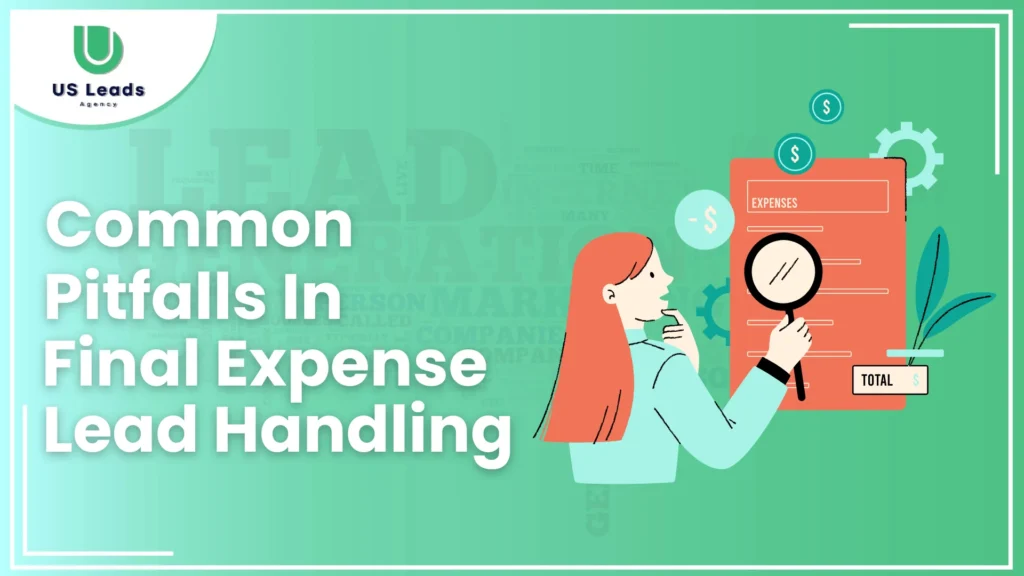
Effectively managing final expense leads is essential for insurance agents aiming to improve conversions and foster long-term client relationships. However, certain pitfalls, such as delayed follow-ups or impersonal communication, can hinder success.
This guide highlights the most common pitfalls in final expense lead handling and provides actionable solutions to overcome them, ensuring better results and stronger client trust.
Key Takeaways:
- Respond quickly to engage prospects and reduce drop-offs.
- Use personalized, empathetic communication to build trust.
- Diversify outreach strategies to connect through multiple channels.
- Manage lead data systematically to ensure consistent follow-ups.
- Educate clients about final expense insurance in simple, clear terms.
Table of Contents
Common Pitfalls In Final Expense Lead Handling:
1. Failing To Respond Quickly:
Pitfall: Delays in responding to leads can cause prospects to lose interest or move to competitors.
Solution: Use automated systems or CRM tools to ensure follow-ups within 5–10 minutes of lead generation. Quick responses demonstrate professionalism and increase engagement rates.
2. Lack of Personalized Communication:
Pitfall: Generic emails or impersonal calls can alienate leads, reducing trust and interest.
Solution: Personalize communication by addressing the client by name, referencing their inquiry, and tailoring the conversation to their needs.
3. Ignoring The Emotional Aspect:
Pitfall: A hard-sell approach in a sensitive market like final expense insurance can make clients uncomfortable.
Solution: Show empathy and understanding. Listen actively to clients’ concerns and reassure them that you’re there to help them plan for their loved ones.
4. Overloading Clients With Information:
Pitfall: Sharing too many details about policies, pricing, and benefits can overwhelm prospects, making it harder for them to decide.
Solution: Simplify your message. Highlight key benefits and provide additional information only when requested.
5. Neglecting Follow-Up:
Pitfall: Failing to follow up after initial contact can lead to missed opportunities.
Solution: Create a structured follow-up process using reminders or automated email sequences. A polite follow-up can re-engage hesitant prospects.
6. Poor Qualification of Leads:
Pitfall: Spending time on unqualified leads reduces efficiency and productivity.
Solution: Implement a lead qualification process. Use pre-screening questions or surveys to assess interest, financial capability, and eligibility.
7. Relying Solely on One Communication Channel:
Pitfall: Limiting outreach to a single channel, like phone or email, reduces connection opportunities.
Solution: Diversify your communication methods. Combine calls, emails, text messages, and social media to connect with leads through their preferred channels.
8. Not Educating Clients About Final Expense Insurance:
Pitfall: Assuming clients understand the value of final expense insurance can lead to missed engagement opportunities.
Solution: Educate clients about the benefits of final expense insurance using simple, non-technical language. Explain how it works, its importance, and its role in financial planning.
9. Failing to Address Objections Effectively:
Pitfall: Agents often struggle to handle objections like cost concerns or misunderstandings, losing potential deals.
Solution: Prepare responses to common objections. For instance, emphasize affordability and flexible payment options when clients express cost concerns.
10. Inconsistent Data Management:
Pitfall: Disorganized lead data can result in missed follow-ups, duplication of efforts, or lost leads.
Solution: Use a reliable CRM system to manage lead data effectively. Track interactions, organize information, and schedule follow-ups to stay on top of your pipeline.
Conclusion:
Avoiding common pitfalls in final expense lead handling can significantly improve your conversion rates and client relationships. By focusing on quick follow-ups, personalized communication, empathy, and systematic lead management, you can maximize opportunities and foster trust with your prospects.
Every lead represents a family seeking peace of mind. With the right strategies, you can position yourself as their trusted partner in end-of-life planning, ensuring mutual success and long-term loyalty.
FAQs:
Why is quick follow-up critical for final expense leads?
Responding within 5–10 minutes shows professionalism and increases the likelihood of engagement.
How can I personalize communication effectively?
Use the client’s name, reference their inquiry, and tailor your approach to their specific needs and concerns.
How can I address cost objections with clients?
Highlight affordability and emphasize flexible payment plans to reassure clients about financial feasibility.
What’s the best way to educate clients about final expense insurance?
Use clear, simple language to explain its benefits, importance, and role in financial planning without overwhelming them.
